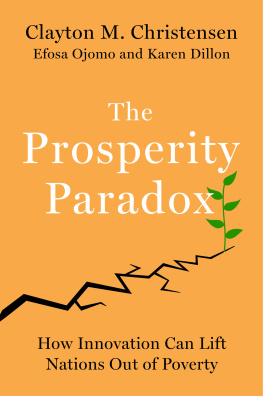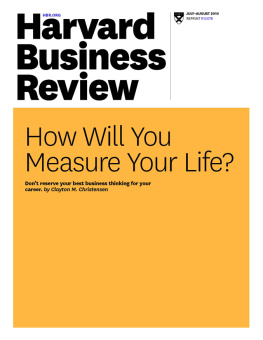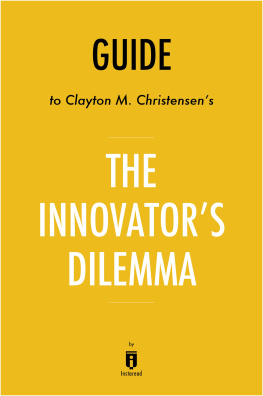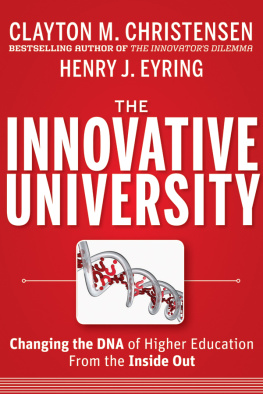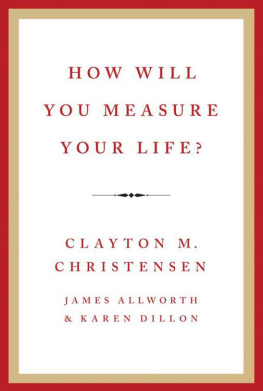I spent two years in the early 1970s serving as a Mormon missionary in South Korea, one of the poorest nations in Asia at the time. In South Korea, I witnessed firsthand the devastating effects of poverty: I lost friends to preventable illnesses and saw families routinely having to make impossible choices among putting food on the table, educating their children, or supporting the older generation. Suffering was part of daily life. I was so moved by that experience that when I received a Rhodes Scholarship to attend Oxford, I decided to study economic development, with a focus on South Korea. I hoped that might lead to a position at the World Bank, where I could try to help solve the problems I had seen in my time in South Korea. The particular year I wanted to join, however, the World Bank wasnt hiring any more Americans. That option was closed to me. So in the twists and turns of fate, I ended up at Harvard studying business instead. But the haunting images of the impoverished country stayed with me.
I am happy to say that when I visit South Korea today, it bears no resemblance to the South Korea I remember. In the decades since I lived there, South Korea has not only become one of the worlds richest countries but has also joined the respected ranks of the Organization for Economic Cooperation and Development (OECD) countries, and has gone from a foreign aid recipient to a foreign aid donor. I could not agree more. South Koreas transformation in just a few decades is nothing short of miraculous.
Unfortunately, such a dramatic transformation has not been possible for many other nations that resembled South Korea a few decades ago. By contrast, Burundi, Haiti, Niger, Guatemala, and many other countries that were desperately poor in the 1970s are still desperately poor. The questions that originally spurred my interest in helping South Korea years ago have continued to nag at me for decades. Why do some countries find their way to prosperity, while others languish in profound poverty?
Prosperity, it turns out, is a relatively recent phenomenon for most countries. Most wealthy nations have not always been prosperous. Consider, for example, the United States. We may forget just how far America has come. Not too long ago, America, too, was desperately poor, rife with corruption, and chaotically governed. By almost any measure, America in the 1850s was more impoverished than present-day Angola, Mongolia, or Sri Lanka.
For decades, we have studied how to stem poverty and create economic growth in poor countries, and we have seen some real progress. For example, the rate of extreme poverty globally decreased from 35.3 percent in 1990 to an estimated 9.6 percent in 2015. Even for those who are not technically living in extreme poverty, survival is still very precarious.
Although it is true that we have certainly made some progress, there seems to be no consensus on how to eradicate poverty. The suggestions range from fixing dismal societal infrastructure (including education, health care, transportation, and so on) to improving institutions, to increasing foreign aid, to boosting foreign trade, and many others. But even those who disagree on the right solution would surely agree with the assessment that progress has been too slow.
| Country | 1960s | 2015 | % change |
| 1 | Burundi | $470 | $315 | -33% |
| 2 | Central African Republic | $677 | $339 | -50% |
| 3 | Malawi | $412 | $353 | -14% |
| 4 | Gambia | $773 | $384 | -50% |
| 5 | Madagascar | $1,108 | $393 | -65% |
| 6 | Niger | $1,196 | $403 | -66% |
| 7 | Liberia | $1,447 | $469 | -68% |
| 8 | Democratic Republic of Congo | $1,742 | $478 | -73% |
| 9 | Togo | $783 | $578 | -26% |
| 10 | Afghanistan | $698 | $615 | -12% |
| 11 | Uganda | $686 | $625 | -9% |
| 12 | Sierra Leone | $1,128 | $675 | -40% |
| 13 | Benin | $802 | $709 | -12% |
| 14 | Senegal | $2,003 | $935 | -53% |
| 15 | Zimbabwe | $2,207 | $1,037 | -53% |
| 16 | Ivory Coast | $1,545 | $1,319 | -15% |
| 17 | Ghana | $1,632 | $1,401 | -14% |
| 18 | Zambia | $2,252 | $1,576 | -30% |
| 19 | Venezuela | $8,507 | $4,263 | -50% |
| 20 | Kuwait | $34,087 | $29,983 | -12% |
Figure 1: Per capita income from 19601969 was averaged to get a 1960s per capita income value. Values were adjusted for inflation.
Source: IMF World Economic Outlook Database
Consider this. Since 1960, we have spent more than $4.3 trillion in official development assistance trying to help poorer countries.
Efosa Ojomo, my coauthor on this book and one of my former students at Harvard, knows firsthand the pain of failing despite well-intended efforts. His experience offers insight into the frustration surrounding so many once-hopeful projects designed to bring better living and working conditions to impoverished economies. Efosa is originally from Nigeria, but he has spent the bulk of his adult life living and working in the United States. So while he recognized the poverty that plagued poor countries, it was somewhat of a distant concern for him, until he found himself reading the dedication in the book The White Mans Burden, New York University professor William Easterlys attack on Western efforts to aid impoverished countries. In this book, Easterly told the story of Amaretch, a ten-year-old Ethiopian girl who rose at three each morning to fetch firewood. She then had to walk miles to sell the firewood in the market to help provide for her family.
Efosa couldnt sleep that night after he read her story. No child deserved to live such a difficult life. So Efosa, together with some of his friends, set up a nonprofit organization, Poverty Stops Here, to raise money to build wells in various parts of his native Nigeria. The lack of water is the first thing that hits you when you visit a poor community, Efosa later shared with me. Water is life. Its why there are so many water projects throughout the world. We just need to get people water. Everything starts there. In a similar vein, when you visit a poor country, the lack of quality education, unpaved roads, bad governance, and other poverty indicators are painfully obvious. Isnt it reasonable to assume that the answer to solving poverty lies in providing one or all of those things?
Efosa managed to raise more than $300,000 and identified five communities in which to help build wells. The day Efosa and his supporters visited those communities to turn on the wells for the first time was one of unmitigated joy, for both Efosa and the local residents. I can imagine there are few more moving sights than seeing plentiful, clean water coming from a well in a village that previously had none.
But as it turned out, wells break down. About six months after building a new well, Efosa would get a call in his Wisconsin home that the water wasnt coming out anymore, and he would have to figure out from thousands of miles away how to get someone in Nigeria to go and fix it. Since all the wells his organization built were in rural areas, finding a skilled technician to source parts and go to the village was always challenging. One problem would be fixed and another would spring up. Today, only one of the five wells that Poverty Stops Here installed is still functional. Efosa and his friends, who had so earnestly set out to help these villages, reluctantly gave up on building additional wells.

